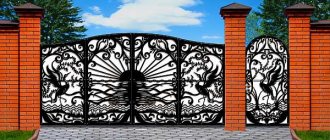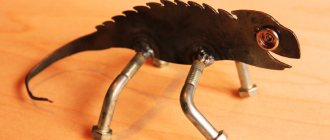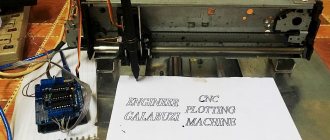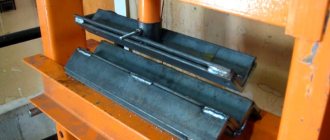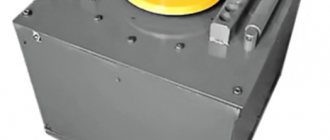Blacksmithing is one of the oldest methods of metal processing. However, even in our age of high technology development, it has not lost its significance and is even gaining great popularity.
Forging with your own hands is a rather difficult technological process; for this you need to know at least the basic techniques for working with a workpiece, as well as the rules for heating and hardening the metal. You also need to have an idea of how to use the equipment. What skills do you need to have to make products using the blacksmith method and how to forge metal?
Interesting about metal forging
Interesting fact, one of the most common surnames in the world comes from blacksmithing. This is Kuznetsov in Russia, in France - Ferrand, in Britain - Smith. This indicates the prevalence of this craft throughout the world.
blacksmith craft
The basis of the word deceit is the verb forge. The fact is that many peoples and tribes considered blacksmithing to be obscure and shrouded in mystery. Kovar (blacksmith) makes forges, knits shackles, so over time the noun cunning denoted wisdom, skills, ability. Over time, it began to mean evil plans and intentions. At the same time, the phrases “forge your happiness” and “forge your destiny”, which have a positive meaning, also appeared.
During the mass unification of production and the use of equipment such as rolling, stamping, the use of computer control practically displaced blacksmithing from heavy industry, but it remained and is popular with designers and interior design specialists. Modern blacksmiths make products that are used to create fences, stairs, architectural design of buildings, etc.
Rolling equipment for cold forging
Hot stamping
But our century has led to the fact that the design of forged products is carried out using special 3D design programs intended for the development of parts for various purposes.
Open forging is used on a variety of metals. With the help of this operation, both household items and objects of artistic value are performed. By the way, this method of metal processing is also used in jewelry. In fact, the most malleable metal is gold. It has plasticity, fluidity, ductility and many other properties that make it possible to obtain priceless products from it.
Jewelry forging
In practice, two main types of forging are used - hot and cold.
Homemade “Snails”
In essence, this is a modernized bending machine (pipe bender), but these improvements make it possible to easily make curls from fairly thick rods (up to 10-12 mm cross-section) and repeat them with a high degree of accuracy.
One of the homemade cold forging machines
These cold forging machines have several designs, but the easiest to implement is the one with a round table with a central leg. A lever with rollers on bearings at the end is movably attached to the leg. They make the bending process easier.
The table surface can be made of steel sheet with a thickness of 10 mm or more. For the leg, you can use any thick-walled round pipe. It is important to make the structure stable, since lateral forces will be applied, so side posts, spacers, and a stable base are needed.
Drawing of a cold forging machine “Snail”
It is easier to make a lever from a square pipe with a thick wall - at least 2-3 mm. The cross-section of the pipe is 25*40 mm or so. Attaching the lever to the leg can be done on a bearing, or you can simply take a small piece of thick-walled pipe of a larger diameter, put it on the leg, and weld a stop strip on the bottom so that the lever does not fall down. The option with a bearing gives easier movement, but if there is lubrication, the second option also works.
Lever mounting option
The shape of the lever is also important. The lever is double, the upper part is working, the lower part is supporting. Wherever there are connections, it is advisable to add reinforcement, since the efforts are significant.
The lever must be reliable, with reinforcement
A mandrel or jig is fixed on the table - the shape along which the curls are bent. They are made in different diameters so that you can make curls of different diameters. Such mandrels can be prefabricated to form a larger number of bends. Each such sample must have rods that are installed in holes in the table. This is how this template is fixed. Also, its shape must be designed in such a way that the end of the rod is well fixed in it.
Variant of conductors for the snail
Often, mandrels are machined from a metal circle of a suitable diameter using a grinder, but there are options made of metal with steel plates welded onto it, curved accordingly.
How to make a similar machine for cold forging is in the next video. There is also a good description of how to bring the ends of the workpiece to a decent state - ordinary raw edges look very rough. There is special equipment for processing them, but, as it turns out, you can do it without it.
Hot forging method
As already noted, hot forging is possible when the metal is heated to temperatures at which it changes its strength characteristics and acquires plasticity, which makes it relatively easy to process using impact tools and various devices. Hot metal processing involves the use of certain metal processing technologies that allow a variety of finished products.
Meanwhile, heating the metal also has certain disadvantages. Firstly, heating the metal means that a forge or muffle furnace must be installed in the workshop. It should be immediately noted that the presence of such equipment implies the presence of costs for its maintenance and fuel. Secondly, the use of open fire is an unsafe activity and requires the master to observe increased safety measures. Thirdly, hot forging requires that the master have certain knowledge and skills regarding the temperature parameters of the metal.
How to heat workpieces correctly?
The final quality of a metal product largely depends on the selected temperature regime for heating the workpiece. The appearance of the product and its durability also depend on this. It should be taken into account that the metal can be processed only when it is brought to the temperature required for forging. Thus, the metal’s resistance decreases, it can be deformed, and the degree of ductility becomes very high.
It is necessary to take into account that each metal has its own temperature regime for forging. This temperature regime is determined by the structure of the workpiece and its chemical composition.
Hand forged
Hand forging of metal must be performed in a specially equipped workshop. The list of equipment includes the following equipment and devices:
- forge or muffle furnace;
- air exhaust system;
An anvil, which is a solid-sized (weighing up to 250 kg) metal pig, which may have such technological devices as horns and calibrated holes. For its manufacture, 45L steel is used.
On an anvil, you can forge metal with your own hands and give heated workpieces the required shapes and sizes.
In addition, there is the possibility of forging a sheet on the surface of the anvil.
Twisters
Since ancient times, blacksmiths have cold-formed curls according to a template-mandrel using a horn lever grip, pos. 1 in Fig. This method is low-productive and not for wimps, but it allows you to quickly and easily make various bending mandrels from an ordinary steel strip: the end (thrust) horn of the lever prevents the template from yielding under the pressure of the workpiece. It is advisable to make the middle (bypass) horn sliding with fixation: the work will go slower, but, especially in inexperienced hands, more accurately.
The simplest devices for cold artistic forging
Another simple device for manual shaped bending is a strong board with support pins - spacers, pos. 2; Ordinary M8-M24 bolts are suitable. Depending on how friendly you are with your home exercise machine, you can work with a strip of up to 4-6 mm. They bend the strip by eye, the work goes slowly, but you can draw patterns up to Ilya Muromets on a horse in full armor or Buddha in a lotus flower. The latter, perhaps, is completely handmade: people who have fully mastered hatha and raja yoga are able to curl steel reinforcements into a pattern with their hands.
Cold forging method
Most cold forging work is performed on equipment specially designed for this purpose. You can name a certain list of equipment that is used for cold metal processing. As a rule, such equipment shows its effectiveness when performing large volumes of work in the architectural design of buildings and structures.
Among the equipment used in the production of cold forging products are the following:
- torsion bar, it is used to twist the rod along its axis;
- wave, various wave-like parts are made on it.
In total, the fleet of cold forging equipment includes about a dozen units. Some are powered by the operator's muscular strength, some are powered by an electric drive. Some craftsmen are engaged in the independent production of such equipment.
Basic patterns
Since iron can change shape during heat and physical treatment, there are various examples of forged patterns. All of them can be divided into three main groups:
- Geometric.
- Vegetable.
- Animals.
Undoubtedly, the most popular of them are floral forged ornaments. The artful interweaving of branches, flowers and leaves has always inspired artists to create fantastic works. Blacksmiths are no exception in this series. They also often use plant motifs in their work.
To make a similar pattern, you need to follow the forging technique
For cold working, metal rods are most often used as the main material. They are bent, twisted, flattened, minted, milled and forged. The end result is magnificent works. Here are the main elements and techniques for this type of metal work:
- Curls. The most popular element. It has a huge number of different options and modifications.
- Spirals. Single, double, spatial and others. This is also a very popular technique that makes patterns for forged products memorable and original.
- Cool. Twisting iron bars can be the most incredible experience. The imagination of some authors is amazing.
- Top. A decorative insert or special atypical treatment of the ends of the rods can greatly diversify and decorate any ornament.
- Coinage. The use of chisels and hammers for decorative inserts in forging patterns is a long-proven and often used way to add creativity to a future creation.
- Headings. Cylindrical, cone-shaped, spherical elements made of rolled metal, attached to the end of a rod.
Types of blacksmithing
Forging is performed using manual or mechanical impact tools, this could be a sledgehammer or a press, which can be powered by an electric, pneumatic or hydraulic drive.
Forging and stamping provide the production of parts that have different overall weight parameters and shapes.
The use of forging leads to an increase in the mechanical parameters of steel and optimizes its internal structure. That is why critical parts, such as connecting rods, are produced using free forging or stamping. Forging can be divided into the following types - hand and machine. For the first, a hand-held percussion tool (hammer, sledgehammer, etc.) is used; all metal processing work is performed on an anvil. The second type of forging is performed on forging equipment equipped with a hammer, etc. When machining, heavy and bulky workpieces are processed under pressing equipment, and smaller ones with less weight are processed using a hammer.
Metal processing by impact can be divided into free forging and die processing. Free forging involves the workpiece being compressed between a press and a base. The formation of the finished part occurs due to the auxiliary tools used by the blacksmith.
Blacksmithing
When stamping, the metal takes on the shape and dimensions within the tool die. To produce a separate part, a new die must be made. In fact, forging and stamping are intermediate technological operations that lead to the production of workpieces, which will subsequently undergo additional processing, for example, milling or welding.
Types of beautiful forged structures: transparent, with the addition of tin and other materials
Useful things for the home with your own hands
Forged structures combine the qualities of aesthetics and functionality. They are assembled from different materials (stainless steel, metal sheets and profile pipes) and are complemented by elements made of polycarbonate, corrugated sheets, tin, sheet metal, wood, stone, concrete.
Forged gates according to the degree of openness are divided into:
Transparent. They consist of vertical balusters and intertwined metal rods that create beautiful ornaments and patterns. Classic products do not hide the garden plot from prying eyes, and the owners will not be able to privacy in their yard.
Forged transparent swing gates. Photo by IP Ninety
Closed. They completely hide from passers-by not only the landscape design, but also the house itself. Blind products combine openwork forging and inserts from other materials.
Blind gates with wood and forging. Photo: Forging manufactory of Valery Litvinov
Wooden and forged structures and products with corrugated sheets are in demand.
Gates and wickets made of corrugated sheets with forged elements are made in the same style. Photos Oboron-stal
There are also models with polycarbonate and sheet metal.
A popular combination is forged gates with brick pillars.
According to the method of opening, forged gates are:
Swing. The designs are simple in design and do not require special maintenance. They can be mechanical (opened manually) or automatic (opened using a remote control). They open both inside and outside the yard. The choice in favor of swing structures should be made based on the availability of free space and the personal preferences of the owners.
Sliding gates with stamped elements. PhotoTHREE MARIE
Retractable. They are ergonomic and save space. The operating principle of sliding structures is quite simple - the gates move in different directions along specially installed rails.
Attention. When choosing decorative elements for sliding gates, keep in mind that when opening they will be hidden behind a section of the fence
Therefore, voluminous and massive ornaments are not recommended.
According to the degree of decorativeness, forged gates are divided into:
Products with simple designs. These include standard gates without frills or decoration. They serve a purely practical purpose, are durable, reliable and easy to use.
Forged single-leaf sliding gates with a laconic design. Photo Deroy
Decorative. They are decorated with a large number of elements: curls, flowers, leaves, baskets, figures, inscriptions, vines, etc.
Forged sliding gates with elements: peaks, rings, commas. Photo KovArt
Types of modern forging equipment
A variety of forging and stamping equipment is widely used in industry. It can be classified according to the following parameters:
- according to the temperature of the workpiece being processed. For this operation, forging machines and equipment for hot and cold stamping, both flat and volumetric, are used;
- on operations performed on equipment. Divide the procurement, main and finishing CSW;
- according to the method of supplying and removing finished products from the workspace of the KShO. In practice, equipment is used on which all these operations are performed manually, in semi- and automatic mode.
- by type of drive. Presses and stamping machines operate on electricity, compressed air, hydraulics, etc.
- by key parameter. As a rule, this is the nominal force created by the press or operating torque.
Choosing a location for a workshop
Of course, small production can be organized in a garage. But there is something to think about here. The production of forged products requires space and not only for production itself. You need a place to store metal and finished products, and this is not a small area, given the size of both. It is necessary to provide a clear path for cars to the workshop, a place for loading and unloading, and basic devices that help this process.
It is also necessary to take into account that this is not a quiet sewing workshop, but a rather noisy production facility that can cause a lot of complaints from residents of neighboring houses, and the owners of garages located nearby may not be happy with such a neighborhood. That is why most people who decide to start such a business set it up on the outskirts of the city and in nearby villages.
And the main point. You need to think about where you will purchase the source material. It is not profitable to transport it from afar. At the same time, it would be nice to find out where your competitors are delivering it from.
DIY forged elements: where would we be without advertising?
Any business, big or small, needs advertising support.
You can use local media for this purpose by posting photos of products, your interview, customer reviews, or a large article about your business.
Advertising banners next to the workshop, on a nearby highway, in individual development villages (after all, small advertising sheets on poles with color photos of products are also advertising).
Use the Internet. For example, at least just submit ads on Avito.
The best advertising is placing your products . So, you can propose to the municipality to place a wrought iron bench in a prominent place in the city.
Good advertising is participation in all kinds of exhibitions, and not only blacksmithing ones; Even a flower exhibition would be suitable, where you can display a wrought iron stand.
Many large and small cities hold festivals of folk crafts, including blacksmiths, on City Day. (For example, annually in August such festivals are held in the ancient city of Ustyuzhna, Vologda region, where blacksmiths come even from abroad).
Feedstock for decorative forged elements
It is necessary to stock up on raw materials for the first time.
The starting materials will be:
- low carbon steel billets;
- metal profile: sheet, pipe, corner, square and so on;
- It is also necessary to have solvents, primers, anti-corrosion paint, and electrodes in stock.
Typically, this can be purchased at bases and in stores.
We are establishing domestic production, opening a “delicious” business: the production of dumplings as a business.
The creation of paving slabs is more relevant today than ever: more and more people want to improve the appearance of their garden, yard and just the surrounding area. Read our article on how to realize yourself in this business.
Fundamentals of the bookmaker business:
